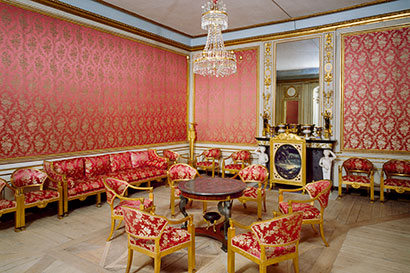Rosersberg Palace's History
Rosersberg got its name from the mother of the estate’s founder, Lord High Treasurer Gabriel Bengtsson Oxenstierna. His mother was descended from the prestigious Tre Rosor (Three Roses) family.
Construction of the palace began in 1634 and was completed four years later. The Oxenstierna palace was typical for its time, with a tall-roofed main building and grand, richly decorated gables in the German-Dutch Renaissance style. The building also includes a large courtyard, bordered by three low-rise wings.
In the second half of the 17th century, the Renaissance palace was considered dated, and the Lord High Treasurer's son, Chancery President Bengt Oxenstierna, had the palace radically modernised in the current Baroque style of the time.
Modernisations by Tessin
For this he engaged the country's leading architect, Nicodemus Tessin the Younger. New wings were added and fitted out with garden grottoes, which have survived to the present day.
The tall Renaissance gables of the main building were demolished and the building was given a hipped roof. A splendid colonnaded gallery survives from that time.
18th century palace
In 1747, Rosersberg was acquired by Baron Erland Broman, and was again greatly modernised. These alterations were likely overseen by one of the country's most prominent 18th century architects, Jean Eric Rehn.
After Broman's death in 1757, the property was acquired by the State and placed at the disposal of the young Duke Karl of Södermanland (later King Karl XIII). This is how Rosersberg became a royal residence.
Karl XIII’s palace
Duke Karl continued the process of comprehensive modernisation and new interior design, still under Rehn's direction. On the death of his brother Gustav III in 1792, Karl (XIII) became Regent for the young King Gustav IV Adolf.
At the end of the 1790s the Palace acquired a number of important new interiors, typified by the Orange and Red Drawing Rooms and the Hogland Room.
Detail of painting “Roserberg Palace viewed from the north” by Louis Belanger, oil on canvas, 1803. Photo: Håkan Lind//Royalpalaces.se

Copperplate of Rosersberg Palace by draftsman Erik Dahlbergh, from the Suecia Antiqua et Hodierna collection of drawings. Photo: Royal library

Queen Desideria’s bed chamber. She was consort to Karl XIV Johan and a good friend of Napoleon Bonaparte. Photo: Håkan Lind/Royalpalaces.se

Karl XIII’s study. The palace was first purchased by Baron Erland Broman. After his death in 1757, the young Duke Karl (XIII) took over the palace. Photo: Alexis Daflos//Royalpalaces.se

The Red Drawing Room, Orange Drawing Room and the Hogland Room are typical examples of the palace’s new interiors from the 1790s. Photo: Håkan Lind//Royalpalaces.se









